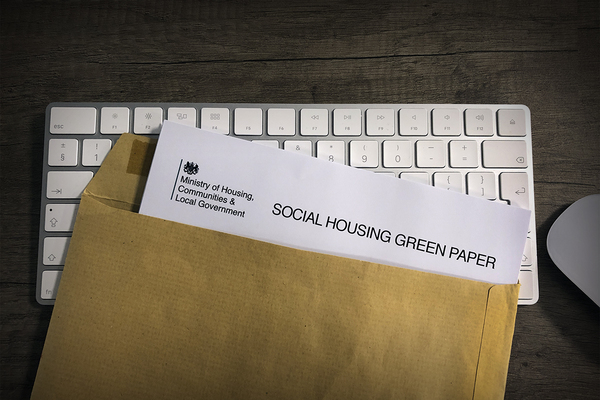You are viewing 1 of your 1 free articles
Grenfell survivors call for split regulator and prison sentences for serious failings
The government should split the social housing regulator in two and establish an ‘accountability framework’ with prison sentences for the worst offenders, Grenfell survivors have said.
In a strongly worded attack on the current system of regulation, survivors group Grenfell United called for the government to set up a new model based on banking regulation.
This would involve splitting the current regulator into two parts: one for economic and one for consumer affairs.
It said this is an approach modelled on the ‘Twin Peaks’ banking regulation where the Prudential Regulation Authority regulates banks’ economic performance and the Financial Conduct Authority focuses on conduct and customer protection.
The group also called for an accountability framework for leaders and managers of social housing similar to the ‘Senior Manager Regime’ in banking.
“An accountability framework backed by law would mean that a named person is responsible for people’s safety in any social housing tower block for example,” the group said.
“There would be consequences for individuals who prioritise profit over people’s safety. It would mean individual failures could lead to sanctions including criminal liability and even fines or prison.
“But really, what we hope it will mean is that leaders take their roles and responsibilities seriously and work hard to make sure those they manage do the same so that failures don’t happen.”
Related Files
It made the call in a formal response submitted to the government’s consultation on the Social Housing Green Paper (below), seen by Inside Housing today.
In it, the group said it did not learn of the regulator’s existence until after the fire in June 2017.
“For us, we thought the [Royal Borough of Kensington and Chelsea Council] scrutiny committee was the highest level at which we could take our concerns, and when they ignored us we thought we had nowhere else to turn,” it said.
“The fire at Grenfell must be seen in part as a total failure of the social housing regulator. For us, the regulator was the dog that didn’t bark. It didn’t come to help us and all trust in this regulator is lost.”
It added: “Stepping back from the Grenfell experience, there are clear reasons why this current system of regulation does not work for tenants. Tenants can only refer cases of ‘serious detriment resulting from systemic failures’ to the regulator for investigation. This doesn’t happen in other sectors.
“The regulator should be proactive and carry out their own inspections.” The ‘serious detriment’ test was introduced by government in 2010, when regulation responsibility was given to the then-Homes and Communities Agency (HCA) with a clear mandate to focus primarily on economic regulation.
The former chair of the regulator, Julian Ashby, has said the body was “constrained” by government in its ability to investigate consumer affairs before the fire.
The organisation has since split away from the HCA to form a standalone body – the Regulator for Social Housing.
The government discussed dropping the serious detriment test and giving the regulator greater powers to intervene in consumer affairs in the green paper.
However, Grenfell United said this proposal was “deeply flawed”.
“You cannot replace the dog that didn’t bark with the same kennel and the same dog. A new system is needed to build trust and offer new hope to social housing tenants,” it said.
The serious detriment test remains in place in law and while the regulator intervenes in a number of consumer cases, it is only able to act on referrals and cannot proactively police these cases until the law is changed.
The Grenfell Tower Inquiry
Closing statements
Day 85: victims' lawyers attack the fire brigade
Further expert evidence
Including some additional evidence from emergency call handlers, bereaved and relatives
Day 84: further evidence from survivors and relatives
Day 83: swift evacuation of tower possible if residents alerted
Day 82: initial fire was extinguished but then returned to the flat
Day 81: overheating fridge-freezer most likely cause of fire
Day 80: fire doors installed did not match product tested
Day 79: resident advised to stay put despite fire in flat
Day 78: insulation and cladding material below required standard
Day 77: molten plastic spread blaze down tower
Day 76: 'stay put' should be dropped when fire spreads across floors
Other witness evidence
Police, ambulance, gas suppliers, council, TMO and call room operators give evidence
Day 75: call room operators give evidence
Day 74: further evidence from TMO officers
Day 73: TMO boss failed to pass information to firefighters
Day 72: fire finally extinguished when gas switched off
Day 71: further questions over stay put advice
Day 70: the police evidence
The bereaved, survivors and relatives’ evidence
Day 69: video shows smoke billowing through fire door
Day 68: KCTMO removed self closing mechanism and never replaced it
Day 67: gaps in cladding fixed with duct tape
Day 66: 'don't fix broken system with a sticking plaster'
Day 65: survivor dragged disabled man down nine floors to safety
Day 64: KCTMO 'did not replace broken fire door'
Day 63: foam insulation inside cladding 'exposed' says survivor
Day 62: father gives harrowing account of son's death
Day 61: council’s management organisation slammed for faulty electrics
Day 60: stay put advice ‘led to deaths’, residents say
Day 59: residents describe problems with new windows
Day 58: survivor describes how daughter saved his life
Day 57: firefighter evidence ‘a slap in the face’, says survivor
Day 56: relations with contractor were ‘toxic’
Day 55: resident 'never happy' with stay-put advice
Day 54: tenant gives evidence about housing association
Day 53: stay put advice 'felt like trap'
Day 52: resident saved by son's phone call
The firefighters’ evidence
Day 51: firefighter feared encouraging residents to jump
Day 50: the LFB commissioner
Day 49: fire chief reveals frustration over lack of building plans
Day 48: internal fire spread 'bigger story' than cladding
Day 47: fire officer considered evacuating crews over building collapse fears
Day 46: 'we were improvising' senior firefighter admits
Day 45: firefighter urged for abandonment of 'stay put' policy
Day 44: firefighter recalls radio signal difficulties
Day 43: call hander 'uncomfortable' with insisting residents stay put
Day 42: residents only told to leave if they called fire brigade back
Day 41: breathing equipment delay 'hampered rescues on upper floors'
Day 40: chiefs told firefighters to abandon policy
Day 39: firefighters reveal dramatic rescue of children
Day 38: firefighters issue aplogies to families
Day 37: council 'unable to provide tower plans'
Day 36: QC defends inquiry process
Day 35: Javid would welcome interim recommendations
Day 34: water from hose 'too weak' to reach the flames
Day 33: 'oh my god, we've been telling people to stay put'
Day 32: further fire fighter describes lack of equipment and low water pressure
Day 31: 'incredibly difficult' task of recording information outlined
Day 30: struggle to maintain control over rescue operation described
Day 29: fire service 'overwhelmed' by survival guidance calls
Day 28: 'the building beat us'
Day 27: firefighters 'forced to abandon plans to reach roof'
Day 26: poor signage hindered rescue efforts
Day 25: water pressure left firefighting equipment 'like garden hose'
Day 24: decision to abandon 'stay put' explored
Day 23: TV images 'could have assissted' rescue effort
Day 22: description of hectic scenes in the control centre
Day 21: account from the fire service 'nerve centre'
Day 20: firefighter describes 'huge volume' of calls from trapped residents
Day 19: firefighter 'given no training on cladding fires'
Day 18: evacuation would have been 'huge catastrophe'
Day 17: firefighters describe access and lift issues
Day 16: scenes of carnage likened to 9/11
Day 15: firefighters recount trauma of survival guidance calls
Day 14: firefighters describe spread of blaze
Day 13: firefighters recall radio difficulties
Day 12: "it was like a war zone"
Day 11: questions raised over fire fighters' radios
Day 10: watch manager emotional under questioning
Day nine: lead firefighter 'not trained in stay put policy'
The expert reports: authors give evidence to inquiry
Day eight: where the fire started
Day seven: what was in the cladding?
Day six: the cause and spread of the fire
Day five: expert highlights key issues
Day four: firefighters defend response to fire
Day three: council and contractors appear for the first time
Day two: lawyers for the survivors make their case
Day one: expert evidence released on cladding and stay put
The commemoration hearings
30 May: Grenfell Council 'recognised it should not house disabled victim above four storeys'
29 May: Anger on day six of the Grenfell Inquiry
25 May: Grenfell families 'forced to live in chimney with stay put policy'
24 May: Grenfell family complained about father being housed on 17th floor
23 May: Tributes to children on third day of Grenfell hearings
22 May: Emotions run high as Grenfell bereaved shown footage of the tower burning
21 May: Grenfell victims share tributes as inquiry opens
Never Again campaign
Inside Housing has launched a campaign to improve fire safety following the Grenfell Tower fire
Never Again: campaign asks
Inside Housing is calling for immediate action to implement the learning from the Lakanal House fire, and a commitment to act – without delay – on learning from the Grenfell Tower tragedy as it becomes available.
LANDLORDS
- Take immediate action to check cladding and external panels on tower blocks and take prompt, appropriate action to remedy any problems
- Update risk assessments using an appropriate, qualified expert.
- Commit to renewing assessments annually and after major repair or cladding work is carried out
- Review and update evacuation policies and ‘stay put’ advice in light of risk assessments, and communicate clearly to residents
GOVERNMENT
- Provide urgent advice on the installation and upkeep of external insulation
- Update and clarify building regulations immediately – with a commitment to update if additional learning emerges at a later date from the Grenfell inquiry
- Fund the retrofitting of sprinkler systems in all tower blocks across the UK (except where there are specific structural reasons not to do so)
We will submit evidence from our research to the Grenfell public inquiry.
The inquiry should look at why opportunities to implement learning that could have prevented the fire were missed, in order to ensure similar opportunities are acted on in the future.





